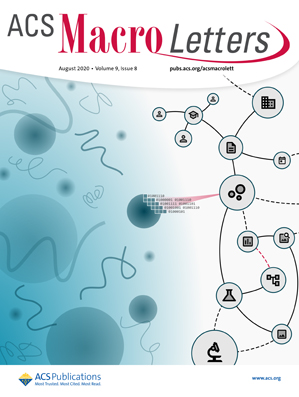Cryo-EM Visualization of Intermolecular π-Electron Interactions within π-Conjugated Peptidic Supramolecular Polymers.
IF 5.1
Q1 POLYMER SCIENCE
引用次数: 0
Abstract
The self-assembly of "π-peptides" - molecules with π-electron cores substituted with two or more oligopeptide chains - brings organic electronic function into biologically relevant nanomaterials. π-Peptides assemble into fibrillar nanomaterials as driven by enthalpic peptide-based hydrogen bonding networks and pi-core-based quadrupolar interactions. A large body of spectroscopic, morphological and computational studies informs on the nature of the self-assembly process and the resulting nanostructures, but detailed structural information has remained elusive. Inspired by the recent use of cryogenic electron microscopy (cryo-EM) to provide high-resolution structures for synthetic peptide nanomaterials, we present here the use of cryo-EM to offer ca. 3 Å resolution of π-peptide nanomaterial assemblies, visualizing for the first time the nature of the intermolecular π-core electronic interactions responsible for energy transport through these supramolecular materials.π共轭肽超分子聚合物分子间π-电子相互作用的低温电镜观察。
“π-肽”的自组装- π-电子核被两个或多个寡肽链取代的分子-将有机电子功能带入生物相关的纳米材料中。π-肽在基于焓肽的氢键网络和基于π核的四极性相互作用的驱动下组装成纤维状纳米材料。大量的光谱、形态学和计算研究揭示了自组装过程的本质和由此产生的纳米结构,但详细的结构信息仍然难以捉摸。受低温电子显微镜(cryo-EM)为合成肽纳米材料提供高分辨率结构的启发,我们在这里展示了使用低温电子显微镜提供约3 Å分辨率的π-肽纳米材料组件,首次可视化了分子间π-核电子相互作用的本质,这些相互作用负责通过这些超分子材料传输能量。
本文章由计算机程序翻译,如有差异,请以英文原文为准。
求助全文
约1分钟内获得全文
求助全文
来源期刊
CiteScore
10.40
自引率
3.40%
发文量
209
审稿时长
1 months
期刊介绍:
ACS Macro Letters publishes research in all areas of contemporary soft matter science in which macromolecules play a key role, including nanotechnology, self-assembly, supramolecular chemistry, biomaterials, energy generation and storage, and renewable/sustainable materials. Submissions to ACS Macro Letters should justify clearly the rapid disclosure of the key elements of the study. The scope of the journal includes high-impact research of broad interest in all areas of polymer science and engineering, including cross-disciplinary research that interfaces with polymer science.
With the launch of ACS Macro Letters, all Communications that were formerly published in Macromolecules and Biomacromolecules will be published as Letters in ACS Macro Letters.

 求助内容:
求助内容: 应助结果提醒方式:
应助结果提醒方式:


